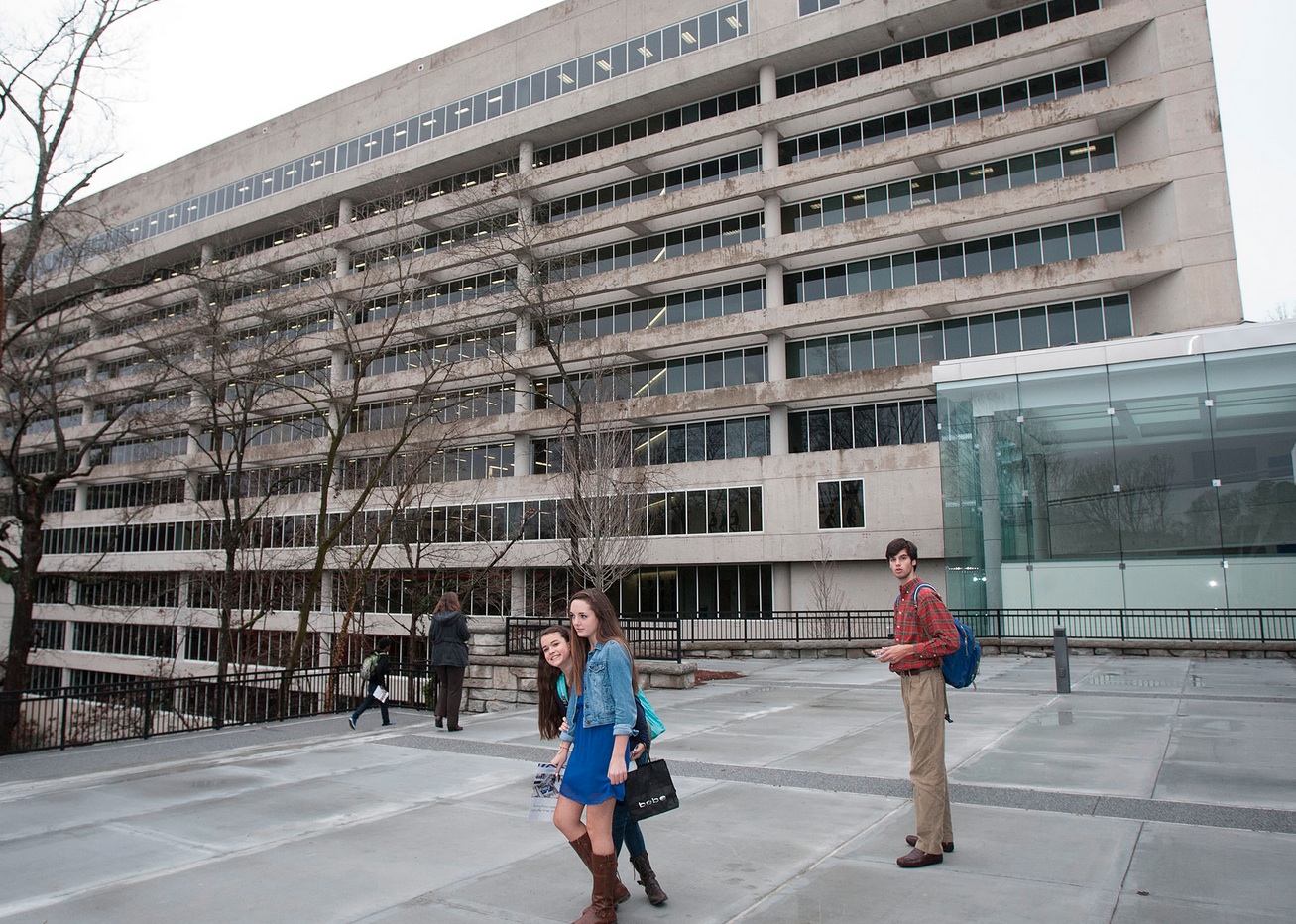With an 11-story former IBM office building, a 9-story annex, and 56 acres of land, architecture firm Cooper Carry created a new high school for 2,350 students in north Atlanta.
The centerpiece of the school is the 11-story Lakeside building, which was originally built in 1977 by Thompson, Ventulett, Stainback & Associates. The building now houses administrative offices, a media center, a cafeteria, and academic classrooms, according to ArtsATL.
The existing parking deck remains, though the parking lots adjacent to the annex building were made into sports fields. The Building Team, which also included Collins Cooper Carusi Architects and Paul Cheeks Architects, decided to demolish the annex and build a new structure to house a 600-seat main theater, a black box theater, music rooms, a 2,100-seat gym, and an auxiliary gym.
Although the Lakeside building retains many signs of its original purpose, like the spacious main lobby with its large columns and retro spiral staircase, the glassed-in main office makes the building's new status as a school clear. The design team played on the building's strengths, especially the floor-to-ceiling windows, which give students and teachers breathtaking views of the forested surroundings. From inside the building, one can see over the treetops to the high-rises around the Cobb Galleria on one side; on the other, they can see downtown Atlanta, Midtown, and Buckhead.
The school's interior is in large part dictated by Atlanta Public Schools' requirements for construction materials, according to ArtsATL. Linoleum floors, stainless steel railings, and drop ceilings are consistent throughout. However, Cooper Carry did play with the color palette and added custom details.
Each grade occupies two stories connected by one large stairway. With a signature color for each grade, visitors can immediately determine where they are in the building. In the central spaces, some of the concrete structure remains exposed and special lights highlight some of the building's architectural features.
The new Hillside building is only two stories, but it stretches over horizontally for over 400 feet. To link the buildings with the parking deck, the architects conceived "Warrior Way," named as an homage to the school's mascot. This low building begins at the parking deck, so when students either drive up or are dropped off, they can immediately go inside. Warrior Way connects the cafeteria in the Lakeside building to the auditorium, gymnasium, and bus drop-off loop at the far end of the Hillside building. In this way, it provides a central axis for the campus. It provides views of the lake between the two buildings, and an outdoor plaza can be accessed from Warrior Way as well.
Here is a photo walkthrough of the building:
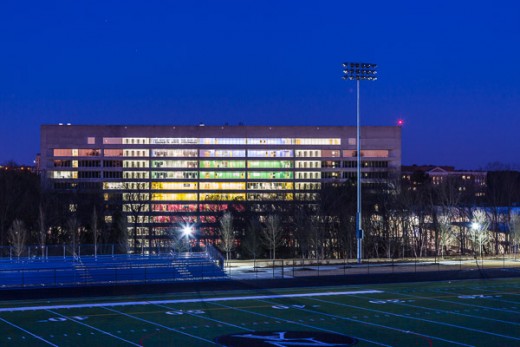
The 11-story Lakeside building is the center of the campus.
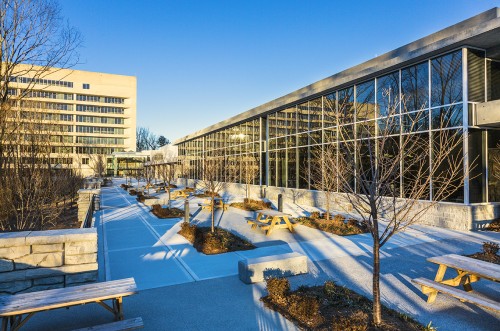
Warrior Way links the Lakeside and the Hillside buildings, and opens up onto an outdoor plaza that can be used for assemblies and socializing.
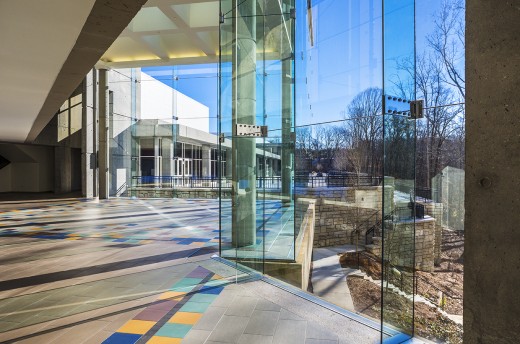
The new Hillside annex is connected to the Lakeside building by a two-story glass atrium.
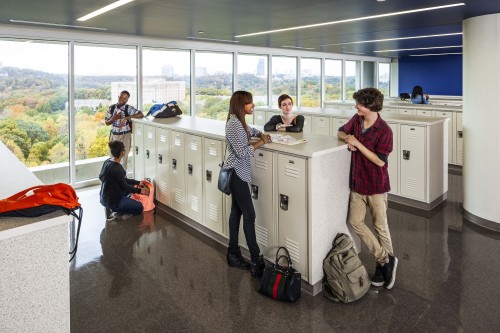
Floor-to-ceiling windows give amazing views of the surrounding property and of the city of Atlanta.
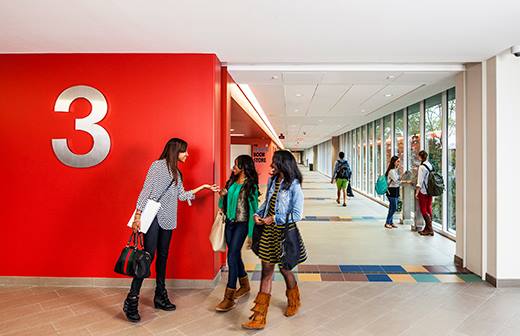
Inside the school, public spaces are marked by the color red.

Every grade has two floors with a signature color; blue marks the two floors housing the 12th grade students.

Concrete and glass are used to unify all of the structures on the campus.

Cross-section depicts the color coding scheme for the high-rise high school
Related Stories
| Dec 14, 2011
Belfer Research Building tops out in New York
Hundreds of construction trades people celebrate reaching the top of concrete structure for facility that will accelerate treatments and cures at world-renowned institution.
| Dec 12, 2011
CRSI design awards deadline extended to December 31
The final deadline is extended until December 31st, with judging shortly thereafter at the World of Concrete.
| Dec 10, 2011
10 Great Solutions
The editors of Building Design+Construction present 10 “Great Solutions” that highlight innovative technology and products that can be used to address some of the many problems Building Teams face in their day-to-day work. Readers are encouraged to submit entries for Great Solutions; if we use yours, you’ll receive a $25 gift certificate. Look for more Great Solutions in 2012 at: www.bdcnetwork.com/greatsolutions/2012.
| Dec 10, 2011
Energy performance starts at the building envelope
Rainscreen system installed at the west building expansion of the University of Arizona’s Meinel Optical Sciences Center in Tucson, with its folded glass wall and copper-paneled, breathable cladding over precast concrete.
| Dec 6, 2011
Mortenson Construction completes Elk Wind Project in Iowa
By the end of 2011, Mortenson will have built 17 wind projects in the state generating a total of 1894 megawatts of renewable power.
| Dec 2, 2011
What are you waiting for? BD+C's 2012 40 Under 40 nominations are due Friday, Jan. 20
Nominate a colleague, peer, or even yourself. Applications available here.
| Nov 22, 2011
New Green Matters Conference examines emerging issues in concrete and sustainability
High-interest topics will be covered in technical seminars, including infrared reflective coatings for heat island mitigation, innovative uses of concrete to provide cooling and stormwater management, environmental benefits of polished concrete, and advancements in functional resilience of architectural concrete.
| Nov 16, 2011
CRSI recommends return to inch-pound markings
The intention of this resolution is for all new rollings of reinforcing steel products to be marked with inch-pound bar markings no later than January 1st, 2014.
| Nov 8, 2011
Transforming a landmark coastal resort
Originally built in 1973, the building had received several alterations over the years but the progressive deterioration caused by the harsh salt water environment had never been addressed.
| Nov 8, 2011
WEB EXCLUSIVE: Moisture-related failures in agglomerated floor tiles
Agglomerated tiles offer an appealing appearance similar to natural stone at a lower cost. To achieve successful installations, manufacturers should provide design data for moisture-related dimensional changes, specifiers should require in-situ moisture testing similar to those used for other flooring materials, and the industry should develop standards for fabrication and installation of agglomerated tiles.


